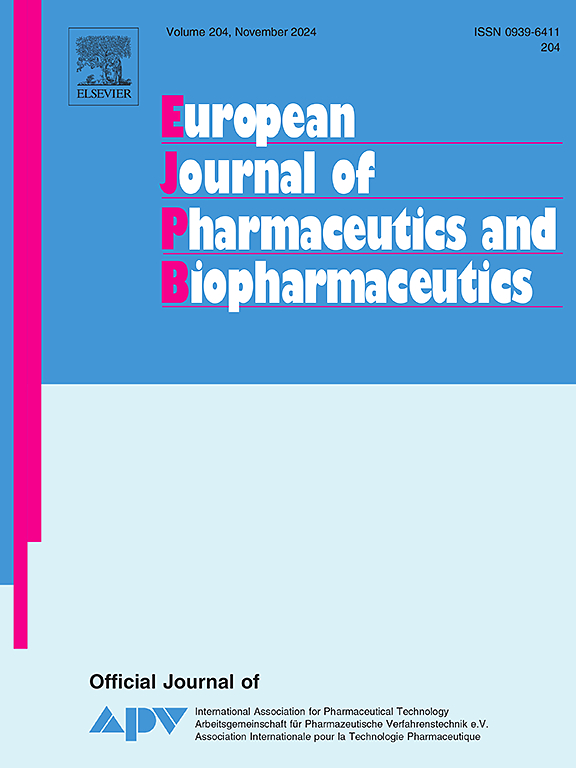Synthesis and Anticancer Activity Evaluation of Self- assembled Curcumin Loaded Gelatin − Oleic acid – Carboxymethyl Chitosan Nanoparticles on MCF-7 cells
IF 4.4
2区 医学
Q1 PHARMACOLOGY & PHARMACY
European Journal of Pharmaceutics and Biopharmaceutics
Pub Date : 2025-04-09
DOI:10.1016/j.ejpb.2025.114718
引用次数: 0
Abstract
Curcumin (CUR) is a natural herb with known anticancer effects against many malignancies such as breast cancer. However, CUR is poorly water-soluble and suffers from low bioavailability, and its delivery to breast cancer through oral administration is interrupted by early release and degradation before reaching the target site. So, this study aimed to develop an oral breast cancer-targeted drug delivery system (DDS) using a combination of biopolymers like mucoadhesive carboxymethyl chitosan, oleic acid and gelatin to create biopolymer-mediated nanoparticles (NPs) for the delivery of hydrophobic CUR. Gelatin-Oleic acid-Carboxymethyl chitosan (GOC) readily self-assembles into nanoparticles (GOCNPs) using the desolvation process. Such self-assembled DDS based on biopolymers without any crosslinkers for the preparation present controlled drug release and enhanced anticancer efficacy compared to existing systems. The prepared GOCNPs were characterized by FTIR, 1HNMR, XRD, SEM, HRTEM, DLS, and Zeta analysis. The DDS’s maximum drug loading efficiency (DLE) and encapsulation efficiency (EE) values at pH 4.0 were 78.0 ± 2.34 % and 94.0 ± 2.8 %, respectively. The CUR-loaded GOCNPs shows a 90.0 ± 2.6 % CUR release at pH 5.5, while the release percentage of CUR at pH 7.4 was only 37.0 ± 1.06 %. According to the MTT data, CUR-GOCNPs show significant cytotoxicity to MCF-7 cells, showed a cell viability of 20.16 % towards MCF-7 cancer cells and loading of CUR to the GOCNPs notably increased its anticancer activity as the IC50 of CUR-GOCNPs was significantly lowered (6.880 µg/mL against MCF-7 in 24 h analysis). Studies on drug release kinetics, cytotoxicity, apoptosis, hemocompatibility, swelling, and in vivo pharmacokinetics were carried out to prove the effectiveness of the biopolymer-based nanoparticles developed as an effective oral delivery system for CUR. The future holds enormous possibilities for the clinical translation of prepared drug delivery system, as advances in controlled drug delivery continue to prove the design and capabilities of GOCNPs.

自组装姜黄素明胶-油酸-羧甲基壳聚糖纳米粒子的合成及其在 MCF-7 细胞上的抗癌活性评估
姜黄素(Curcumin, CUR)是一种天然草药,对许多恶性肿瘤如乳腺癌具有抗癌作用。然而,CUR的水溶性较差,生物利用度低,口服给药给药到乳腺癌的早期释放和降解在到达靶部位之前被中断。因此,本研究旨在开发一种口服乳腺癌靶向药物递送系统(DDS),该系统将黏附性生物聚合物(如羧甲基壳聚糖、油酸和明胶)结合在一起,制备生物聚合物介导的纳米颗粒(NPs),用于疏水性CUR的递送。明胶-油酸-羧甲基壳聚糖(GOC)通过脱溶过程容易自组装成纳米颗粒(GOCNPs)。与现有系统相比,这种基于生物聚合物的自组装DDS的制备不需要任何交联剂,具有药物释放控制和抗癌功效增强的特点。采用FTIR、1HNMR、XRD、SEM、HRTEM、DLS和Zeta分析对制备的GOCNPs进行了表征。DDS在pH 4.0下的最大载药效率(DLE)和包封效率(EE)分别为78.0±2.34%和94.0±2.8%。在pH为5.5时,载CUR的GOCNPs的CUR释放率为90.0±2.6%,而在pH为7.4时,CUR的释放率仅为37.0±1.06%。根据MTT数据,CUR-GOCNPs对MCF-7细胞表现出显著的细胞毒性,对MCF-7癌细胞的细胞存活率为20.16%,并且在24小时的分析中,CUR-GOCNPs的IC50显著降低(对MCF-7的IC50为6.880µg/mL),显著提高了其抗癌活性。通过对药物释放动力学、细胞毒性、细胞凋亡、血液相容性、肿胀和体内药代动力学的研究,证明了生物聚合物纳米颗粒作为一种有效的口服给药系统的有效性。随着可控给药技术的进步,GOCNPs的设计和能力不断得到证实,未来制备的药物给药系统的临床应用前景广阔。
本文章由计算机程序翻译,如有差异,请以英文原文为准。
求助全文
约1分钟内获得全文
求助全文
来源期刊
CiteScore
8.80
自引率
4.10%
发文量
211
审稿时长
36 days
期刊介绍:
The European Journal of Pharmaceutics and Biopharmaceutics provides a medium for the publication of novel, innovative and hypothesis-driven research from the areas of Pharmaceutics and Biopharmaceutics.
Topics covered include for example:
Design and development of drug delivery systems for pharmaceuticals and biopharmaceuticals (small molecules, proteins, nucleic acids)
Aspects of manufacturing process design
Biomedical aspects of drug product design
Strategies and formulations for controlled drug transport across biological barriers
Physicochemical aspects of drug product development
Novel excipients for drug product design
Drug delivery and controlled release systems for systemic and local applications
Nanomaterials for therapeutic and diagnostic purposes
Advanced therapy medicinal products
Medical devices supporting a distinct pharmacological effect.

 求助内容:
求助内容: 应助结果提醒方式:
应助结果提醒方式:


